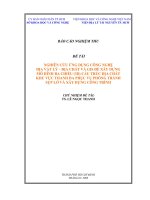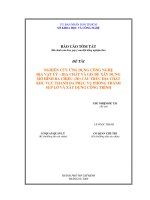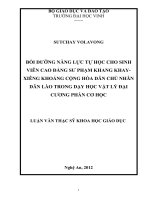VẬT lý địa CHẤN grativity tt
Bạn đang xem bản rút gọn của tài liệu. Xem và tải ngay bản đầy đủ của tài liệu tại đây (1.17 MB, 29 trang )
Some Gravity Basics
Newton’s Law of Gravitation states that the force of attraction F between two
masses m1 and m2 whose dimensions are small with respect to the distance r
between them is given by the equation below, where G is the Gravitational
Constant (6.67x10-11 m3kg-1s-2).
Gm1m2
F=
2
r
r
m1
m2
•The attractive force between two small masses is proportional to the product of
their masses – doubling either mass doubles the force, doubling both masses
quadruples the force.
•The attractive force is inversely proportional to the square of the separation –
doubling the separation reduces the attraction by a quarter.
Some Gravity Basics
For the case of a mass above the earth we can re-write the previous equation
using ME as the mass of the Earth, ms as the mass of the object, and RE as
the distance between the centers of the objects
GM E
F=
ms = ms g
2
RE
GM E
g=
RE2
RE
ms
=
RE
ME
ms
ME
•Force is related to mass by acceleration, and the term g is known as the
gravitational acceleration.
•In the case of a uniform sphere, it can be approximated to a “point mass” of
smaller radius but equal mass.
•The attractive force of an irregular body can be calculated by approximating it as a
series of smaller bodies.
Some Gravity Basics
GM E
g=
RE2
RE
ms
ME
•On a spherically symmetric earth the value of g would be the same everywhere.
• We would not know anything about the composition of the earth – it could be a
hollow shell, have a hollow center, etc.
•Luckily the earth is highly heterogeneous.
What is the mass of the earth?
Radius at equator = 6378160 m
G = 6.672x10-11m3kg-1s-2
g = 9.78 ms-2
The Mass of the Earth
GM E
gR 2
9.78 ms −2 * (6378160 m) 2
24
g=
→
M
=
→
M
=
≈
5
.
96
*
10
kg
E
E
2
−11
3
−1 − 2
RE
G
6.67 *10 m kg s
What is wrong with this number given the
values in the adjacent table?
From Kearey et al., 2002
What assumptions are made??
Using this mass, we can calculate that the
average density of the earth is about 5500
kg m-3 (5.5 Mg m-3).
Rock Densities
•In the case of a homogeneous, spherically symmetric earth, gravity is constant. This
is obviously not the case in reality. Gravity varies over the earth’s surface for a
number of reasons, one of which is variations in density.
•Density is typically measured in units of kg m-3 – how do we measure density?
•Most common rocks range in density from 1500-3000 kg m-3 (e.g. granite = 25002800 kg m-3, basalt = 2700-3000 kg m-3). A few metalliferous ores have densities well
above 3000 kg m-3 (e.g. magnetite ore = 4900-5300 kg m-3).
•Densities of common rocks overlap, so they have limited use for lithological
identification.
•Densities of weathered and/or exposed rocks tends to be less than their buried
counterparts, so care has to be taken when collecting samples for density
measurements and when interpreting gravity surveys -- WHY??
•Gravity anomalies are the result of density contrasts.
•In this example, the density contrast, Δρ,
= 300 kg m-3. What might these rock types
be??
2700 kg m-3
2400 kg m-3
Gravity Units
Gravity variations are very small. Suppose that
in the previous example the center of the
sphere is at a depth of 100 m and it has a
radius of 50 m.
Δρ = 300 kg m-3
•If an object is dropped on the ground above
the sphere it will fall with a little greater
acceleration than an object dropped to the
side. The excess gravity due to the sphere is:
d = 100 m
r = 50 m
G∆m G 4 3
= 2 πr ∆ρ
2
d
d 3
G 4
3
−6
-2
∆g =
π
50
*
300
=
1
.
048
*
10
m
s
100 2 3
∆g =
•As would be expected, this is a very small value, and rather inconvenient to use. To
make things easier, we use mGal (note that G is capitalized to honor Galileo).
1 mGal = 10-5 m s-2
•The buried sphere thus produces an anomaly of 0.1048 mGal.
Measuring Gravity
1. Time the fall of an object – this can be done accurately in the lab, but it is not
practical for the field. Absolute gravity.
2. Measure the period of a pendulum – the period depends on the dimensions of
the pendulum and the value of gravity. Same problems as 1. Accuracy of 0.001
mGal. Absolute gravity.
3. Measure relative gravity using the principles of a spring balance. This can be
converted to absolute gravity by taking a measurement at a point where
absolute gravity is known.
Here, an increase in gravity has caused an increase in the
weight of a mass, resulting in a spring of length s being
stretched by an amount Δs. The extension of the spring is
proportional to the extending force (Hooke’s Law).
m
m∆g = k∆s and ∆s = ∆g
k
k is the elastic spring constant
Measuring Gravity
In this example, the fact that the spring acts as a
measuring device and a support for the mass restricts the
accuracy of the instrument. This was however the basis of
early instruments known as stable gravimeters
From Kearey et al., 2002
Δs, the extension of the spring, must be measured to an accuracy of 1:10 8 for
gravity surveying on land. This is the same as, measuring the distance from here to
Birmingham (assuming 80 km) to an accuracy of 0.8 mm.
The problem of a dual role spring is overcome in an
unstable gravimeter, an example of which is the LaCoste
and Romberg gravimeter.
•The meter consists of a hinged beam carrying a mass
supported by a spring attached immediately above the
hinge.
•The magnitude of the moment exerted by the spring on the
beam is dependant upon the extension of the spring and
the sine of the angle θ.
•By suitable design of the spring and beam geometry the
magnitude of the increase in restoring force with increasing
gravity can be made as small as possible.
•A zero-length spring is used -- pre-tensioned in manufacture so that the restoring
force is proportional to the physical length of the spring rather than the extension.
•The instrument is read by restoring the beam to horizontal by altering the vertical
location of the spring attachment. The number of screw turns is the reading.
From Kearey et al., 2002
Unstable Gravimeters
Unstable Gravimeters
As changes in temperature can cause
changes in the length of the spring, a
thermostat keeps the instrument at a
constant temperature. Other things to
worry about:
•Make sure the meter is perfectly level.
•Check the meter temperature.
•In a micro-gravity survey make sure
that you always take the
measurements from the same side of
the meter.
•Take notes about the terrain
immediately surrounding the meter
(e.g. are you next to a boulder).
•Don’t take readings following an
earthquake.
•Don’t bump the meter.
•Capable of measurements to an accuracy
of 0.01 mGal across a 5000 mGal range.
Unstable Gravimeters
Another type of unstable gravimeter is the Worden meter.
•Similar design to the LaCoste and Romberg, but two springs support the beam –
one is the measuring device and one alters the level of the 200 mGal reading
range.
•Thermal effects are minimized by using quartz components and a bimetallic strip
that automatically compensates for temperature changes.
•Restricted reading range makes it unsuitable for transcontinental measurements.
Gravity can be measured at sea by lowering a meter to the seabed and remotely
leveling and reading it.
•Laborious – meter has to be lowered to the seabed for each reading.
•Strong currents can lead to location uncertainty
Shipboard LaCoste & Romberg
•Accuracy reduced (to about 1 mGal) due to the severe
vertical and horizontal accelerations causing variations in
gravity of up to 100,000 mGal.
•Effects of horizontal accelerations caused by waves, yawing
of the ship (turns about the vertical axis) and changes in
speed and heading can be largely eliminated by mounting
the gravimeter on a gyrostabilized table. Deviations of the
table from horizontal may cause leveling errors of <1 mGal.
•Gravity variations resulting from vertical wave motion can be
cancelled by averaging the readings over an interval much
longer than the maximum period of the wave motion (~8
seconds).
•Cross-coupling – vertical accelerations cause the beam to
oscillate. If the beam is tilted out of horizontal it is further
displaced by the turning force associated with the horizontal
acceleration. These beam motions do not cancel out with
time. Corrected using accelerometers on the stabilized
platform.
From Kearey et al., 2002
Bell BGM3 Gravimeter
•Mounted on a stable platform.
•A DC current passed through the coil causes the
mass to act as a magnet.
•In the null position the weight of the mass is
balanced by the forces exerted by the permanent
magnets.
•When the mass moves vertically due to waves or a
change in gravity the motion is detected by a servo
loop which regulates the current in the coil, driving
the mass back to the null position.
•The varying current is a measure of the change in
gravity.
•Lower drift rate than many meters.
From Kearey et al., 2002
•Accelerometer (34 mm high, 23 mm in diameter)
consists of a mass wrapped in a coil that is
constrained to move only vertically between two
permanent magnets.
Gravity Reduction
Drift Correction
•Over time the spring in a LaCoste and Romberg gravimeter will gradually extend.
•If at the end of every day we take a reading at a base station we can track the drift
rate of the meter.
•If we assume that the meter drifts linearly, we can remove the effect of drift from
measurements taken during the day
From Goodliffe, 1993
•The more accurate the survey, the more frequently you should visit the base
station.
Gravity Reduction
Latitude Correction
•
Gravity varies with latitude because:
1. The Earth is not spherical. Centrifugal force has given it an equatorial bulge.
Thus a point on the equator is further away from the center of the earth. This
acts to reduce gravity. The amplitude of this effect is reduced by the fact that
the mass underlying equatorial regions is greater than that underlying polar
regions.
2. The angular velocity of a point on the earth’s surface decreases from a
maximum at the equator to zero at the poles. This acts to fling bodies away
from its rotation axis.
Gravity at the poles exceeds gravity at the equator by ~5,186 mGal.
From Kearey et al., 2002
•
Gravity Reduction
Latitude Correction (continued)
•
As both effects vary with latitude they can be combined into a single formula,
Caliraut’s formula.
gθ = 978031.8(1 + 0.0053924 sin 2 θ − 0.0000059 sin 2 2θ )
Where gθ is the predicted value of gravity at latitude θ and 978031.8 is the
value of gravity at the equator. The equation with the above constants is also
know as the International Gravity Formula 1967.
The value gθ gives the predicted value of gravity at sea-level at any point on the
Earth’s surface, and is subtracted from the observed gravity to correct for
latitude variation.
Gravity Reduction
Free-Air Correction
•The free-air correction is one of three topographic corrections. Two more will
follow.
g=
GM E
RE2
.
•To reduce to datum an observation taken at height h:
FAC = 0.3086h mGal (h in meters)
•The FAC is positive for an observation point above the datum to correct for the
decrease in gravity with elevation.
From Kearey et al., 2002
•The free-air correction (FAC) corrects for the decrease in gravity with height that
is due to an increased distance from the center of the earth – remember:
Bouguer Correction
•The second topographic correction is the Bouguer correction. The FAC takes into
account the height of the station – the gravitational attraction of the rock between
the observation point and the station is ignored.
•The Bouguer correction removes the effect by approximating the rock layer
beneath the observation point as an infinite horizontal slab with a thickness equal to
the elevation of the observation above the datum.
BC = 2πGρh = 0.04193 ρh mGal, ρ in Mg m -3
•On land the Bouguer correction must be subtracted, as the gravitational attraction
of the slab needs to be removed.
•At sea the correction is positive to account for the lack of rock between the surface
and the sea bead – the water is replaced by rock. The above equation becomes:
BC = 2πG ( ρ r − ρ w ) z
Where z is the water depth, ρw is the density of water, and ρr is the density of rock.
From Kearey et al., 2002
Gravity Reduction
Gravity Reduction
Terrain Correction
•The final topographic correction. The Bouguer correction make the assumption
that the topography around the observation point is flat – this is rarely the case.
•This correction is always positive.
•The regions designated A forms part of the Bouguer correction slab although
they do not exist. The Bouguer correction has hence overcorrected and their
effect must be restored.
From Kearey et al., 2002
•Region B consists of rock that has been excluded from the Bouguer
correction. It exerts an upward attraction at the observation point causing
gravity to decrease. Its attraction thus must be added.
Gravity Reduction
Terrain Correction (cntd)
•Terrain corrections are classically carried out using a Hammer chart.
•Divided by radial and concentric lines into 130 compartments.
•Outermost zone extends to almost 22 km – beyond this topographic effects
are usually negligible.
•Chart is laid on a map with the observation point at its center – the average
elevation of each compartment is calculated and the elevation of the
observation point subtracted.
•Gravitational attraction of each compartment is determined by reference to
tables.
•The terrain correction is the sum of all the compartments
•It is difficult to fully automate this step, especially for the inner rings of the
hammer chart
Gravity Reduction
Tidal Correction
•Gravity measured at a fixed location will vary with time because of periodic
variations in the gravitational effects of the Sun and Moon.
•These gravitational effects also cause the shape of the earth to vary in much the
same way that the celestial attractions cause tides in the sea.
•Solid earth tides are smaller than oceanic tides and lag further behind lunar motion
(the effect of the moon is greater than that of the sun).
•Solid earth tides cause the elevation of a point to vary by a few cm, thus varying its
distance from the center of the earth.
•Maximum amplitude of 0.3 mGal.
•Tidal variations are predictable and can be easily calculated.
Gravity Reduction
Eötvös Correction
•Applied to gravity measurements taken on a moving vehicle, e.g., a ship or a
helicopter.
•Depending on the direction of travel of the vehicle, the motion will generate a
centripetal acceleration which either reinforces or opposes gravity
•The correction is:
EC = 4.040v sin α cos θ + 0.001211v 2 mGal
Where v is the speed in km hr-1, α is the heading, and θ is the latitude.
•The correction is positive for motion from east to west.
•Approximately 2.5 mGal for each kph in an east-west direction at 55 oN
Free-air and Bouguer Anomalies
FAA = g obs − gθ + FAC (± EC )
BA = g obs − gθ + FAC ± BC + TC (± EC )
The Bouguer anomaly forms the basis for the interpretation of land gravity
data. Typically the Free-Air anomaly is used at sea. More advanced Fourier
methods for the calculation of Bouguer anomalies at sea are available.
Gravity Anomalies
The gravitational attraction in the direction of the mass is given by:
∆g r =
Gm
r2
Since a gravity meter only measures the vertical component of the
attraction Δgz, the gravity anomaly Δg caused by the mass is:
Gm
Gmz
cos
θ
or
∆
g
=
r2
r3
From Kearey et al., 2002
∆g =
Gravity Anomalies
Gmz
∆g = 3
r
This equation can be used to build up the gravity anomaly of many simple
geometric shapes by constructing them from a suite of small elements which
correspond to point masses and then summing (integrating) the attractions of
these elements to derive the anomaly of the whole body.
Integration of the above equation in the horizontal direction provides the equation
for a line mass extending to infinity in that direction:
∆g =
2Gmz
r2









